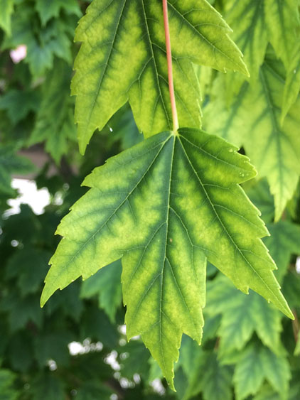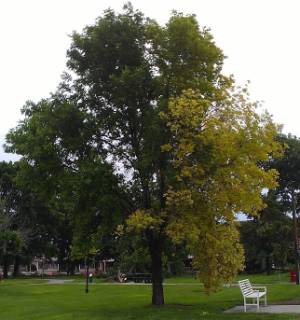Iron Chlorosis
Iron Chlorosis affects many trees and shrubs in the Butler County. This issue is caused by one of two things, soils deficient in iron or soils where the pH restricts the ability of plants to take up iron. In our area iron chlorosis is caused by the second. Iron is readily available in soils where the pH is between 5.0 and 6.5, when the pH is 7.0 and above the iron changes to an insoluble form and is not available to trees. Iron chlorosis is most common in pin oaks, silver maples, sweetgum, baldcyprus and even hydrangea plants.
Iron plays a big role in producing chlorophyll, the green pigment in the  leaves, and one of the earliest signs that your plant has this issue is yellow-green leaves with green veins. Trees suffering from iron chlorosis often have leaves that emerge early in the year be a normal size while leaves emerging later in the year are smaller and often more yellow in color. In advanced stages this issue can turn the leaves fully brown and twig dieback may be observed toward the top of the tree. Eventually the lack of iron will weaken the tree to the point that it dies. In areas where the soil pH is highly variable some trees may only show symptoms on one side of the tree.
leaves, and one of the earliest signs that your plant has this issue is yellow-green leaves with green veins. Trees suffering from iron chlorosis often have leaves that emerge early in the year be a normal size while leaves emerging later in the year are smaller and often more yellow in color. In advanced stages this issue can turn the leaves fully brown and twig dieback may be observed toward the top of the tree. Eventually the lack of iron will weaken the tree to the point that it dies. In areas where the soil pH is highly variable some trees may only show symptoms on one side of the tree.
Luckily there are treatments that can help the tree survive this issue. If a rapid response is needed, a foliar spray of iron sulfate or iron chelate may be applied to the leaves while the tree is leafed out. This provides the quickest response but it only helps the leaves that are already formed so any new leaves will be yellow in color. Lowering the pH of the soil is also an option if you have had the soil tested. This method, unfortunately, is the most difficult to do as the soil will eventually slowly move back to the pH it was at originally. For this treatment you add a sulfur product to the soil such as sulfur, iron sulfate, aluminum sulfate or a liquid injection to the soil according to the soil test results you received. The products are applied under the canopy of the tree out beyond the dripline for best results. The final option is where you inject or implant an iron solution into the trees. This usually sees a response in a couple weeks. This can be done either by an arborist or by a homeowner. The concern with the injections is that the wounds made to inject the product can provide an entry for disease causing organisms. Whichever treatment option you choose will depend on your circumstances. Just be aware that treatments may only work for one year and this will be an ongoing treatment issue. It’s also important to note that iron chlorosis is not the only issue that causes yellow leaves so if you have questions be sure to contact our office.


Have questions? Contact our office where our Horticulture Extension Agent will assist you with questions.
Phone: (316) 321-9660
Email: callae@ksu.edu